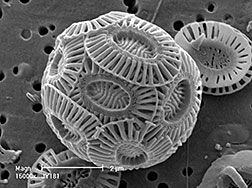- Number 391 |
- June 24, 2013
“Armored” alga’s dual role in the carbon cycle

Scanning electron micrograph of a single
Ehux cell. Ehux is an example of a
coccolithophore. (Jeremy Young)
Towering structures that mark the point at which England is closest to continental Europe, the chalky white cliffs of Dover are built from the exoskeletons of single-celled photosynthetic alga known as Emiliania huxleyi. Even though the process by which the alga’s “armor” forms releases carbon dioxide, Ehux can trap as much as 20 percent of organic carbon, derived from CO2, in some marine ecosystems. Its versatility in either contributing to primary production of organic compounds from carbon dioxide or adding to CO2 emissions makes Ehux a critical player in the marine carbon cycle. Sequenced by DOE's Joint Genome Institute (DOE JGI), the Ehux genome was compared with sequences from other algal isolates and the results reported in the June 12, 2013 edition of Nature. Researchers also hope that the genome will offer insights into the formation of the alga’s calcium carbonate shell, information that could lend itself to applications related to bone replacement, periodontal reconstruction and the treatment of diseases. Read the full story at http://bit.ly/13JGI_Ehux.
[Massie S. Ballon , 925.927.2541,
mlballon@lbl.gov]
